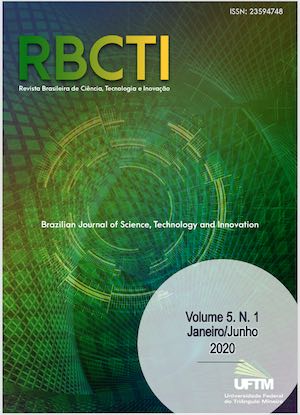Analysis of vibration signals produced by the cavitation in centrifugal pumps using the Power Spectrum and Continuous Wavelet Transform
DOI:
https://doi.org/10.18554/rbcti.v5i1.3413Palavras-chave:
cavitation, centrifugal pumps, vibration signals, time-frequency analysisResumo
The cavitation phenomena cause noise, vibration and instability in centrifugal pumps. Furthermore, the cavitation usually generates wear and material erosion of the rotor blades which decreases the hydraulic performance and the pump life. In this work, it will be studied the vibration components produced by the centrifugal pumps cavitation using the signal processing and statistical analysis. For this purpose, the vibration signals were measured in three directions, x, y and z using accelerometers near to the rolling bearing of the pump with and without cavitation. In this way, an analysis of the power spectrum was applied in order to identify which direction would be more sensitive to the presence of the cavitation in the pump. Subsequently, the Continuous Wavelet Transform was applied to the vibration signals in the time domain for analyzing the vibration components caused by the cavitation. The results proved that this methodology can serve as a tool of analysis and identification of vibration components caused by the cavitation in centrifugal pumps.Referências
CERNETIC, J.; PREZELJ, J.; CUDINA, M. Use of Noise and Vibration Signal for Detecting and Monitoring of Cavitation in Kinetic Pumps. In: Proceedings of Acoustics 08 Paris, Euronoise, p. 2199 – 2204, 2008.
COHEN, L. Time-Frequency Analysis. 1. ed. New Jersey: Prentice Hall, 1995.
CUDINA, M. Detection of the Cavitation Phenomena in a Centrifugal Pump Using Audible Sound. Mechanical Systems and Signal Processing, v. 17, n. 6, p.1335 – 1347, 2003.
HENEGHAN, C.; KHANNA, S. N.; FLOCK, A.; ULFENDAHL, M.; BRUNDIN, L.; TEICH, M. C. Investigating the Nonlinear Dynamics of Cellular Motion in the Inner Ear Using the Short Time Fourier Transform and Continuous Wavelet Transform. IEEE Transactions on Signal Processing, v. 12, n. 12, p. 3335 – 3353, 1994.
LOUGHLIN, P.; CAKRAK, F.; COHEN, L. Conditional Moments Analysis of Transient with Application to Helicopter Fault Data. Mechanical Systems and Signal Processing, v. 14, n. 4, p. 511 – 522, 2000.
OLIVEIRA, R. J. Cavitação: como entender este fenômeno? Disponível em: http://mgstecnologia.com.br/noticias/admin/arquivos/Cavitacao.pdf. Acesso em: 24 nov. 2018.
RAMADEVI, R. Classification of Vibration Signal to Detect Pump Cavitation Using Discrete Wavelet Transform. International Journal of Computer Applications, v. 93, n. 10, p. 36 – 39, 2014.
SAKTHIVEL, N. R.; SUGUMARAN, V.; NAIR, B. B. Comparision of Decision Tree-Fuzzy and Rough Set Fuzzy Methods for Fault Categorization of Mono-Block Centrifugal Pump. Mechanical Systems and Signal Processing, v. 24, p. 1887 – 1906, 2010.
ZHANG, N.; YANG, M.; GAO, B.; LI, Z. Investigation of Vibration Characteristics in a Centrifugal Pump with Special Slope Volute. Advances in Mechanical Engineering, v. 7, n. 2, p. 1 – 14, 2014.






